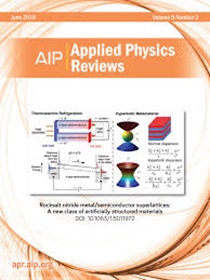2D layered halide perovskite for field-effect transistors
IF 11.9
1区 物理与天体物理
Q1 PHYSICS, APPLIED
引用次数: 0
Abstract
Field-effect transistors are crucial components for modern electronics, generating significant research and profitable interest. Metal halide perovskites have recently emerged as a pioneering active material in solar cells, generating interest in their potential use in other electronic and (opto)electronic devices, including field-effect transistors and phototransistors. However, before they can be commercialized, they still face significant challenges owing to their immanent instabilities with respect to heat, moisture, and light. In contrast, due to their exceptional environmental stability, the newly emerging two-dimensional Ruddlesden–Popper type perovskites have garnered significant recognition. The current state of the field is covered in this review article, as are the problems, and a perspective for the scenarios of perovskite field-effect transistors. The effects of temperature, light, and measurement conditions are taken into account, as well as the physics of the device and the fundamental mechanisms that drive these devices, such as ion migration and ionic defects. Subsequently, the performance of perovskite transistors and phototransistors described so far is analyzed and critically evaluated. Finally, the major roadblocks to perovskite transistor advancement are identified and explored. The lessons learned from other perovskite optoelectronic devices are investigated in order to address these obstacles and bring these devices closer to industrial implementation.用于场效应晶体管的二维层状卤化物过氧化物
场效应晶体管是现代电子产品的关键元件,引起了人们对其研究和盈利的极大兴趣。最近,金属卤化物过氧化物成为太阳能电池的先驱活性材料,引起了人们对它们在其他电子和(光)电子设备(包括场效应晶体管和光电晶体管)中潜在用途的兴趣。然而,在实现商业化之前,它们仍然面临着巨大的挑战,因为它们在热量、湿度和光照方面存在不稳定性。相比之下,新兴的二维 Ruddlesden-Popper 型过氧化物晶石因其卓越的环境稳定性而获得了广泛认可。这篇综述文章介绍了这一领域的现状、存在的问题以及对包晶石场效应晶体管应用前景的展望。文章考虑了温度、光线和测量条件的影响,以及器件的物理原理和驱动这些器件的基本机制,如离子迁移和离子缺陷。随后,对迄今为止描述的包晶晶体管和光电晶体管的性能进行了分析和严格评估。最后,确定并探讨了阻碍光致发光晶体管发展的主要障碍。为了解决这些障碍,使这些器件更接近工业化应用,还研究了从其他包晶体光电器件中吸取的经验教训。
本文章由计算机程序翻译,如有差异,请以英文原文为准。
求助全文
约1分钟内获得全文
求助全文
来源期刊

Applied physics reviews
PHYSICS, APPLIED-
CiteScore
22.50
自引率
2.00%
发文量
113
审稿时长
2 months
期刊介绍:
Applied Physics Reviews (APR) is a journal featuring articles on critical topics in experimental or theoretical research in applied physics and applications of physics to other scientific and engineering branches. The publication includes two main types of articles:
Original Research: These articles report on high-quality, novel research studies that are of significant interest to the applied physics community.
Reviews: Review articles in APR can either be authoritative and comprehensive assessments of established areas of applied physics or short, timely reviews of recent advances in established fields or emerging areas of applied physics.
 求助内容:
求助内容: 应助结果提醒方式:
应助结果提醒方式:


